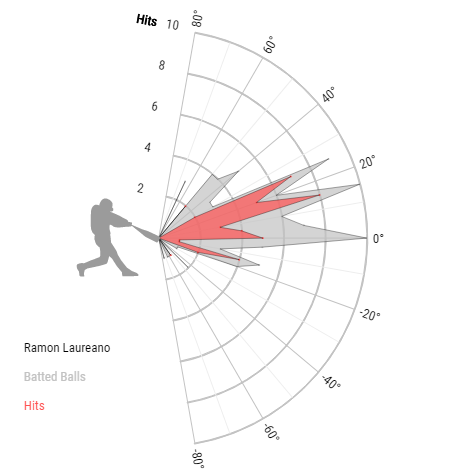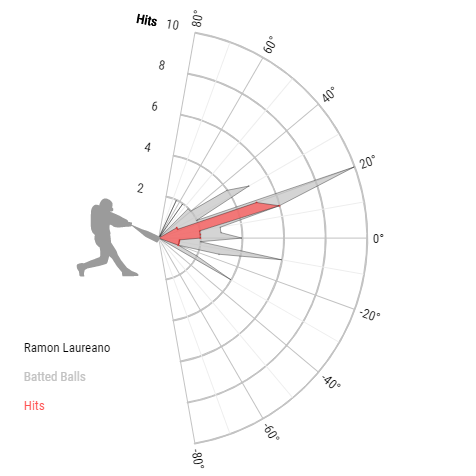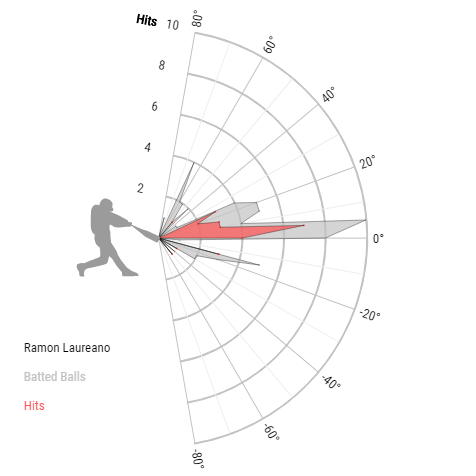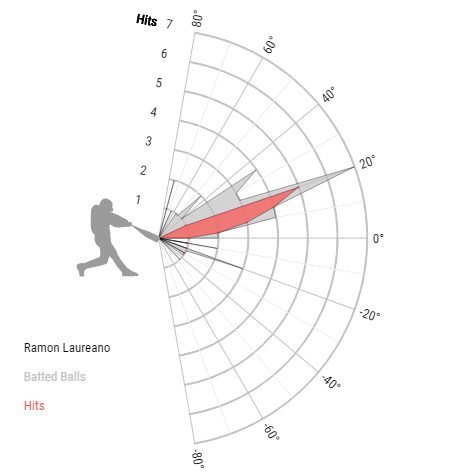I love outfield assists. To me, nothing is more perfect than watching an outfielder with a rocket arm rear back and let loose. You can’t actually see their faces, but I like to believe they get a glint in their eye like an old west gunslinger staring down the barrel of their rifle. This has caused many an outfielder to crow-hop their way into my heart from Ichiro Suzuki, Yeonis Cespedes, Jeff Francoeur, and Larry Walker to Ken Griffey Jr., Vlad Guerrero, Raul Mondesi, and Bobby Abreu. It’s genuinely one of my favorite things in baseball. The thing is that over the last few years with Cespedes constantly hurt and father time finally winning its battle with Ichiro, it’s been a little while since I had fallen in love with an outfielder with a cannon for an arm. Then in 2018, Ramon Laureano came into my life and this happened.
Swoon. Instantly I was head over heels. Watch the whole video for some incredible angles on the throw but that’s just unreal. There have been home runs hit this year that were shorter than that throw. It didn’t stop there. Despite not making his MLB debut until August 8th of last year, he racked up nine outfield assists which put him a mere three assists away from leading the league. He missed the first four months of the season and he nearly led the league in assists anyways! He wasn’t just a one-trick pony though, as he did incredible things at the plate as well by slashing .288/.358/.832 with 5 HRs and 7 SBs over minuscule 176 plate appearances. Many of us wondered if we were looking at the next .280/20/20 stud outfielder who was the perfect combo of power and speed with the defensive prowess to get tons of playing time. It was simply a question of whether or not his hitting was sustainable.
Unfortunately, 2019 started out looking to make us all look like fools, as he hit .234/.291/.646 with a 75 wRC+ and we had to worry if, good defense be darned, that a trip down to AAA was in order for the A’s center fielder. The A’s stuck with him though and once the calendar turned to May, Laureano caught fire, building from a steady burn to a raging inferno in June. Check out the progression:
| Month | PA | AVG | OBP | OPS | HR | R | RBI | 2B |
| March/April | 117 | .234 | .291 | .646 | 3 | 16 | 11 | 4 |
| May | 104 | .286 | .317 | .776 | 3 | 14 | 7 | 8 |
| June | 88 | .284 | .330 | .885 | 6 | 13 | 19 | 4 |
The OPS jump each month stands out like a sore thumb. Now let’s put that into perspective with his debut season along with May and June of this year:
| Year | PA | AVG | OBP | OPS | HR | R | RBI | 2B | SB |
| 2018 | 176 | .288 | .358 | .832 | 5 | 27 | 19 | 12 | 7 |
| May + June 2019 | 192 | .285 | .323 | .826 | 9 | 27 | 26 | 12 | 6 |
Those stretches look remarkably similar but two things really stand out to me, first the difference in OBP and perhaps most importantly the massive difference in HR power. That’s going to be key here but before we get there I want to continue a more general comparison before we dive into that power gap. How about advanced stats?
| Year | PA | BB% | K% | ISO | wOBA | wRC+ | BABIP | HR/FB% |
| 2018 | 176 | 9.1% | 28.4% | .186 | .357 | 129 | .388 | 14.7% |
| May + June 2019 | 192 | 3.6% | 25.5% | .218 | .344 | 118 | .341 | 17.6% |
They still line up pretty well. Laureano’s ISO and HR/FB% seem to indicate that Laureano is sacrificing some power for overall hitting but it’s worth noting that his BABIP in May and June this year are way more reasonable compared to 2018’s .388. To have his BABIP to drop 47 points while staying pretty steady production-wise is actually a really great sign for the sustainability of Laureano’s output over the last two months. It also tends to imply to me that he’s getting better quality of contact as his results are much less luck-based than in 2018 (more on this soon).
There is one stat in this comparison that has me a bit concerned: his BB%. Over the last two months, his BB% is nearly a third of what it was in 2018. If you factor in the six and a half years Laureano played in the minors, you have a lengthy track record of a 9.0 BB% or higher. In fact, only two of those years (at A and his second year at AA ball respectively) did he have a BB% below 9.0%, so it feels reasonable to expect that number to rebound. I don’t want to take it for granted though, so let’s see if there is any dramatic change in his plate discipline numbers from last year.
It’s not definitive but I think I have a pretty good idea as to where that drop in BB% is coming from. Take a look at his Swing%, Z-Swing% (how often he swings at pitches in the zone), Z-Contact% (how often he makes contact with pitches in the zone), and Contact%. His Swing% is up 7.0%, which his Z-Swing% is up 6.4%. These two numbers tell me that he is being way more aggressive with swinging at pitches in the zone. A leap this large doesn’t usually happen just by random chance, it’s almost always the mark of a deliberate change in mentality and approach; I suspect this is no different. Then you factor in that Contact% and Z-Contact% have held steady despite the increased Swing% and you can see how that leads to way more balls in play. To further reinforce this, of the 1,221 pitches Laureano has seen, 97 of them (7.9%) came in three-ball counts. For comparison’s sake, in 2018 he saw 727 pitches and 71 of them came with at least three balls (9.8%). By being aggressive, Laureano isn’t getting as deep into counts as last year, but it’s hard to argue with the results. I wouldn’t be shocked if his struggles during the first month or so of the season were due to adjusting to this new more aggressive mentality.
Now let’s talk about that power. Look again at the power numbers I listed above.
| Year | PA | BB% | K% | ISO | wOBA | wRC+ | BABIP | HR/FB% |
| 2018 | 176 | 9.1% | 28.4% | .186 | .357 | 129 | .388 | 14.7% |
| May + June 2019 | 192 | 3.6% | 25.5% | .218 | .344 | 118 | .341 | 17.6% |
In 2018 Laureano hit five home runs. In May of 2019, he hit three, and in June so far he has crushed six. Let’s break down the above numbers even further:
| Year | PA | HR | 2B | ISO | FB% | HR/FB% |
| 2018 | 176 | 5 | 12 | .186 | 31.5% | 14.7% |
| May 2019 | 104 | 3 | 8 | .173 | 34.7% | 12.0% |
| June 2019 | 88 | 6 | 4 | .272 | 43.4% | 23.1% |
It’s hard not to be impressed by the leap Laureano seemingly has made so far in June 2019. Especially with that increased fly ball rate and insane ISO. Let’s look at it from a different angle. What kind of fly balls is Laureano hitting? Here are his launch angle charts (you really didn’t think I wouldn’t include launch angle charts? How little you know me.)
First his 2018 chart:

Looks pretty darn good to me. The vast majority of his hits were above zero degrees, as were the majority of his batted balls. The big thing to pay attention to here though is how many batted balls he put into play at or above 25 degrees, which is the minimum launch angle needed to qualify as a fly ball.
Now for April 2019:

The hits Laureano got back in April were exactly where we want to see them, with the majority falling somewhere between 15 and 25 degrees, but as you can see the group as a whole almost seems rotated downward, which might indicate he was just a bit off in his swing and therefore whacking more balls into the ground than he was in 2018. Don’t worry, it gets better.
May 2019:

This is really interesting. All of his hits are still above zero degrees, but again it’s almost like you took his batted ball data and rotated it downwards. This gets me wondering if much of Laureano’s struggles in April might have actually been the product of some bad luck, especially when you note the sheer volume of batted balls in April that fell perfectly in the 10 to 25-degree range that indicates line drives. Now for the Piece De La Resistance, June 2019:

That’s perfect. Frame it and hang it up in the Louvre—it’s a work of art. You can see the increase in FB% represented in the grey spikes. Note how when you compare this with the 2018 launch angle chart, more of said spikes now sit above the 20-degree mark. It’s almost as if the elevated grey spikes dragged the launch angle spikes for all his hits all the way back up into the ideal hit range. In the month of June, Laureano put 53 balls into play and a mere nine of them (17.0%) had a launch angle below zero degrees. 21 of them (40.0%) had a launch angle higher than 25 degrees. His hits though are where things get interesting.
| Launch Angle Range | # of hits |
| Below 0 degrees | 3 |
| Between 0 and 10 degrees | 4 |
| Between 10 and 25 degrees | 13 |
| Above 25 degrees | 3 |
Look at that! 13 of his 23 hits (57.0%) were line drives and when you factor in the other fly ball hits we’re talking more like 70% of his hits. The increased batted balls can only mean good things for Laureano moving forward. Now that we’ve seen the kind of hits he’s getting and how elevating his FB% can help him get more of them, let’s ask ourselves the question we always come back around to: How legit is the results? For that, we’ll need to look at the Statcast data alongside some other luck indicators.
| Time Period | BA | xBA | SLG | xSLG | HR | pHR | IFH% | BABIP |
| March/April 2019 | .234 | .252 | .355 | .432 | 3 | 2.82 | 3.4% | .299 |
| May 2019 | .286 | .283 | .459 | .424 | 3 | 2.82 | 10.0% | .362 |
| June 2019 | .284 | .258 | .556 | .465 | 6 | 5.64 | 23.5% | .309 |
There’s a decent amount to unpack here. The xBA shows at first glance that in terms of batting average Laureano got a bit unlucky in April and fairly lucky in June. As an attempt to explain this I have included his IFH% (Infield Hit %). A player with Laureano’s excellent speed (Sprint Speed of 28.6 feet per second) should get a fair amount of infield hits. These hits would likely be discounted by xStats in general, so that 23.5 IFH% in June may help explain why he outperformed his xBA in that month. pHR supports his home run output, while I think the lowered xSLG in June again is a reflection of his IFH%. I honestly don’t know what to make of his BABIP, as in the minors he never had a BABIP lower than .350, but only once did he have a FB% greater than 40.0% (and that was in Single-A ball), so perhaps we should expect a lower BABIP to reflect his higher FB%. It’ll be worth monitoring as the season goes on. If the FB% holds up he should establish a new BABIP baseline for us to evaluate from. I feel like once you factor in the IFH% the xStats and luck stats pretty well support Laureano’s 2019 results as being legitimate.
Okay, now that we’ve examined Laureano’s season and also evaluated the veracity of the results, it’s a question of what this means for the rest of his season. Laureano has had three very different months so far this season. One where nothing worked but got pretty unlucky, another where he hit for a high average but didn’t elevate the ball enough, and a finally a third month where he hit like he was Mike Trout for 26 days. How do we take that information and extrapolate it across the entire season? I’m reluctant to take any single month and use it as the extrapolation point. If you include 2018’s numbers, we have a 368 PA sample of success (roughly two thirds of a full season) that lines up pretty uniformly against a 117 PA sample of unlucky struggles, so I’m willing to lean towards using the May/June combination from earlier in the article. As a refresher here are those numbers from his 2019:
| Year | PA | AVG | OBP | OPS | HR | R | RBI | 2B | SB |
| 2018 | 117 | .234 | .291 | .646 | 3 | 16 | 11 | 4 | 4 |
| May/June 2019 | 192 | .285 | .323 | .826 | 9 | 27 | 26 | 12 | 6 |
Now if you were to take and roughly extend those May and June numbers to a full season using proportions this is what it would look like:
| Year | PA | AVG | OBP | OPS | HR | R | RBI | 2B | SB |
| March/April 2019 | 117 | .234 | .291 | .646 | 3 | 16 | 11 | 4 | 4 |
| May/June 2019 | 192 | .285 | .323 | .826 | 9 | 27 | 26 | 12 | 6 |
| 2019 ROS | 324 | .285 | .323 | .826 | 15 | 46 | 44 | 20 | 10 |
| 2019 Prorated Total | 633 | .275 | .317 | .790 | 27 | 89 | 81 | 36 | 20 |
Well hello there. I think if you had told folks before the season that Laureano would hit at a pace for 25+ HRs and 20 SBs, we would have been drafting him in the first ten rounds. We’d have also told you to flip those numbers around and maybe we’d believe you. I think it’s important to pump the brakes though. Baseball is a season of ebbs and flows—hot and cold streaks—and to take a straight proration as gospel would be a grave mistake. It works more to give us a baseline to work with and to evaluate a third of a season’s stats in the format we’re most comfortable using for perspective, namely as a full season. Before the season, most people who were high on Laureano said that he had the potential to hit 15+ HRs and steal 25+ bases, but that was before he started hitting the ball in the air at the rates he has in 2019. Given that we are two weeks from the All-Star break and Laureano already has 12 HRs, I think we can readjust those expectations to 20+ HRs. It will be interesting to see how he paces out his steals over the rest of the season, but I still think he has a shot at 20+ SBs as well. So with our new view on Laureano, I would expect him to finish with something along the lines of a .275 AVG with 22+ HR, 80+ R, 70+ RBI, and 22+ SBs.
In a vacuum, if I asked you to guess how owned a .270, 20 HR/20 SB hitter across fantasy leagues, you guess 70% – 80% right? Wrong. Here’s the Laureano’s ownership on each of the major sites:
| Site | Ownership % |
| Yahoo | 44% |
| CBS | 60% |
| ESPN | 31.5% |
Laureano is still out there, ripe for the picking. If you’re hurting in stolen bases or a fourth or fifth outfielder then Laureano is the perfect hitter to add to your team right now. When I started doing research for this article a few days ago, those numbers were even lower, so people are starting to catch on quickly. I know in Yahoo leagues, for instance, his ownership has gone up nearly 14% since then, so I’d say now is the time to add Laureano before it’s too late. It’ll be fascinating to see which Ramon Laureano shows up for the rest of the season, but I know I’m going to be watching closely and, based on the information that we’ve uncovered today, I’m expecting big things. Frankly, you should too.
(Photo by Brian Rothmuller/Icon Sportswire)

In a 12 team points league would you rather have Puig or Laureano ros? Based off of this article & Ben’s Add/Drop column, I’m intrigued by both.
It’s Puig for me, Brian. The full season numbers don’t look good, but ever since taking 4 days off back in late May, he’s slashing .284/.328/.624 with 10 home runs and four steals in 116 PA. He’s been very good, and while I like Laureano and think he has a bit more speed, Puig provides better all-around value.
I’m really excited about Laureano but I think I still have to go with Puig at this stage of the season. His ceiling is just so much higher in GABP with more power and it looks like he’s heating up. I guess it would depend on price but if both are on the wire I’m going Puig while still being really high on Laureano.
Gotcha. They are both currently on waivers & would step in as my 3rd outfielder or UTIL. Of Austin Riley and Jorge Soler, which would you be more willing to drop for Puig, if either?
I really like this guy and have bounced back and forth with him and Verdugo as a 4th bench OF. Any thoughts on how you’d compare these guys ROS or longer term even?